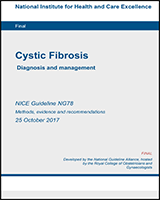From: 9, Pulmonary monitoring, assessment and management

NCBI Bookshelf. A service of the National Library of Medicine, National Institutes of Health.
| Comparison 4. Ibuprofen versus placebo | ||||||
|---|---|---|---|---|---|---|
| Outcomes | Illustrative comparative risks* (95% CI) | Relative effect (95% CI) | No of Participants (studies) | Quality of the evidence (GRADE) | Comments | |
| Assumed risk | Corresponding risk | |||||
| Placebo | Ibuprofen | |||||
| Adverse effects: increase in abdominal pain Follow-up: 2 years | 56 per 1000 | 14 per 1000 (2 to 124) | RR 0.26 (0.03 to 2.24) | 142 (Lands 2007) | ⊕⊕⊝⊝ low1 | |
| Adverse effects: Increase in abdominal pain Follow-up: 4 years | 163 per 1000 | 122 per 1000 (42 to 353) | RR 0.75 (0.26 to 2.17) | 84 (Konstan 1995) | ⊕⊝⊝⊝ very low1,2 | |
| Adverse effects: Gastrointestinal bleeding Follow-up: 2 years | 0 per 1000 | 0 per 1000 (0 to 0)2 | RR 3.08 (0.13 to 74.46) | 142 (Lands 2007) | ⊕⊕⊝⊝ low1 | |
| Annual rate of change in % ideal body weight Follow-up: 4 years | The mean annual rate of change in % ideal body weight in the placebo groups was −0.94 | The mean annual rate of change in % ideal body weight in the ibuprofen groups was 0.99 higher (0.17 to 1.81 higher) | 84 (Konstan 1995) | ⊕⊕⊝⊝ low3,4 | ||
| [Under 13 years at randomisation] Annual rate of change in % ideal body weight (by age) – Follow-up: 4 years | The mean annual rate of change in % ideal body weight (by age) - under 13 years at randomisation in the placebo groups was −1.5 | The mean annual rate of change in % ideal body weight (by age) in the ibuprofen groups was 1.45 higher (0.33 to 2.57 higher) | 49 (Konstan 1995) | ⊕⊕⊝⊝ low3,4 | ||
| [13 years or older at randomisation] Annual rate of change in % ideal body weight (by age) Follow-up: 4 years | The mean annual rate of change in % ideal body weight (by age) - 13 years or older at randomisation in the placebo groups was −0.15 | The mean annual rate of change in % ideal body weight (by age) in the ibuprofen groups was 0.34 higher (0.61 lower to 1.29 higher) | 35 (Konstan 1995) | ⊕⊝⊝⊝ very low1,3 | ||
The basis for the assumed risk (e.g. the median control group risk across studies) is provided in footnotes. The corresponding risk (and its 95% confidence interval) is based on the assumed risk in the comparison group and the relative effect of the intervention (and its 95% CI).
Abbreviations: CI: confidence interval; MD: mean difference; RR: risk ratio
The quality of the evidence downgraded by 2 due to serious imprecision as 95% CI crossed 2 default MIDs.
Absolute effect not calculable as there are 0 events in control (placebo) arm.
The quality of the evidence was downgraded by 1 due to reporting bias.
The quality of the evidence downgraded by 1 due to serious imprecision as 95% CI crossed 1 default MID.
From: 9, Pulmonary monitoring, assessment and management

NCBI Bookshelf. A service of the National Library of Medicine, National Institutes of Health.